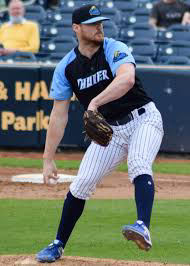
A Strategic Pivot: How the Orioles Turned a Lost Season Into a Farm System Win
As the 2025 Major League Baseball season unfolded, the Baltimore Orioles found themselves facing a sobering reality. Despite a hopeful start rooted in the promise of a talented young core, the team gradually slipped down the standings. As the losses piled up and the playoff hopes dimmed, the Orioles front office faced a difficult decision: continue chasing a fading dream or cut their losses and begin preparing for the future. Ultimately, they chose the latter, becoming one of the most proactive teams in the league in terms of trading away veterans and reshaping their organizational trajectory.

This shift did not come lightly. Baltimore gave their roster every opportunity to right the ship, hoping that some mid-season magic would help them climb out of the hole they had dug earlier in the campaign. But as July drew closer to the trade deadline, the writing on the wall became unmistakably clear—their postseason ambitions were not going to be realized this year.
When it became evident that the 2025 season would not culminate in playoff baseball for Baltimore, the club took decisive action. They embraced the role of sellers and leveraged their expiring contracts to secure young, promising talent from teams still in contention. Rather than letting those players walk for nothing at the end of the season, the Orioles took a more calculated and strategic route, flipping them for prospects and draft capital that could contribute in the long-term rebuilding process.

Among the flurry of moves made by the Orioles, one trade stood out both for its timing and the return it generated. Baltimore shipped relief pitcher Bryan Baker to the division-rival Tampa Bay Rays, a move that occurred just before the 2025 MLB Draft. While the Orioles would go on to make several other trades in the following days, this one in particular has drawn significant attention from analysts and executives alike for the surprising value it brought in return.
Baker, a 30-year-old reliever, was the only player Baltimore traded who was not on an expiring contract. In fact, he remains under team control through the 2028 season. This made the trade somewhat unique in that the Orioles weren’t just offloading a rental player—they were moving a controllable asset. And yet, despite this, many viewed Baker as a middle-tier bullpen arm, not necessarily the type of player who would typically fetch a high return.
But Baltimore’s front office, led by General Manager Mike Elias, pulled off what is now being widely considered one of the shrewdest deals of the trade deadline. In return for Baker, the Orioles acquired the No. 37 overall pick in the 2025 MLB Draft, a competitive balance round selection that was originally held by the Rays. That pick was later used to select Slater de Brun, a highly regarded high school outfielder out of Summit High School in Bend, Oregon.
The trade, and the subsequent pick, raised eyebrows across the league, especially among former executives turned analysts. Jim Bowden, a former MLB general manager and now a writer for The Athletic, highlighted the move in his post-deadline analysis. He referred to it as the “Player who was acquired but should not have been” in one of his superlative categories. His point was clear: the Rays may have overpaid for a reliever by surrendering a first-round draft pick.
Bowden, like many others in baseball, was stunned that a club like Tampa Bay—known for its tight budgeting and draft-conscious philosophy—would be willing to part with such a valuable asset for a reliever like Baker. While Baker certainly has value, particularly due to his contractual control and serviceable stats, the return seemed outsized for his profile.
Through parts of multiple seasons at the Major League level, Baker had accumulated 1.7 bWAR (Baseball Reference Wins Above Replacement) across 177.1 innings pitched, posting a career ERA of 3.71. These are respectable numbers for a middle reliever—consistent and solid, but not elite. Baker was not typically used in high-leverage situations or entrusted with closing duties. He served his role capably, often working the sixth or seventh innings to bridge the gap to the late-inning arms. For the Orioles, however, he became a valuable trade chip, especially when packaged with the idea of controllable years and bullpen depth for a playoff-aspiring team.
From Baltimore’s perspective, turning a non-closing reliever into a first-round draft pick was nothing short of remarkable. The organization has been building through the draft for several years, and many of their current cornerstone players—Gunnar Henderson, Jackson Holliday, and Adley Rutschman, to name a few—were acquired via smart selections and player development.
Now, with the addition of Slater de Brun, the Orioles hope they’ve added another potential impact player to this exciting young core. De Brun was considered one of the most electric prep outfielders in the country heading into the 2025 Draft. Standing out in both speed and bat control, his skillset attracted a great deal of attention from scouts. There’s no guarantee with high school prospects, of course, but the upside with de Brun is significant.
If he develops as expected and eventually makes it to the Major Leagues, the Orioles may look back on the Bryan Baker trade as one of the most lopsided transactions of the year. Even if de Brun doesn’t become a star, the opportunity to develop a young player with such potential is worth far more than the value a middle reliever might provide over the next few years, especially for a team that isn’t in win-now mode.
What makes this trade even more fascinating is that it reflects a broader philosophy shift in Baltimore’s approach to roster construction. Rather than desperately clinging to the fading possibility of contending this season, the Orioles’ front office made a tough, but smart, decision to pivot and prioritize the future. It’s the kind of cold-blooded, long-view calculation that often separates perennial contenders from teams that remain mired in mediocrity.
By acting decisively at the deadline, Baltimore was able to maximize the return for their expendable assets. This allowed them not only to improve their minor league system, but also to create opportunities for younger players already in the organization to step into larger roles at the big-league level. Clearing roster space and reallocating resources are essential parts of any rebuild, and the Orioles managed to do both efficiently.
The Baker trade wasn’t the only move made, of course. Baltimore offloaded several other veterans nearing free agency, capitalizing on short-term value to strengthen their future outlook. Yet, among all the moves, the deal with Tampa Bay stood out for its ingenuity and return. The idea that a competitive balance draft pick—a highly coveted asset especially for teams like the Rays—could be flipped for a serviceable bullpen piece was surprising to many within baseball circles.
For Tampa Bay, the calculation might have made sense in a different context. The Rays are notoriously efficient with their resources, and acquiring a reliable, controllable reliever fits their model. In the heat of a postseason chase, bullpen depth can be invaluable. However, giving up a first-round pick, even a supplemental one, remains a steep price—particularly when that pick results in a high-upside high school talent.
This deal illustrates how different teams assess value depending on their window of contention. For Baltimore, the 2025 season was about building toward something greater in the future. For Tampa Bay, it was about patching immediate needs in a push for October glory. Time will tell which club made the better decision, but the early consensus leans toward Baltimore having made a shrewd, opportunistic move.
Baltimore’s patience in letting the season unfold before making a final judgment also deserves praise. Rather than panicking in May or June, they gave their core a real chance to recover. When it became clear that recovery was unlikely, they acted quickly and decisively. This balance between hope and realism is a difficult one to strike in professional sports, but the Orioles appear to have handled it with poise and purpose.
In the coming months and years, as prospects acquired from these trades develop and move through the minor league ranks, Baltimore fans will get a clearer picture of the payoff. For now, however, the organization has taken the first step toward building a sustainable future. The addition of Slater de Brun, in particular, gives them yet another intriguing name to monitor as the team builds toward a new competitive window.
While this season may not have gone as planned, the Orioles have managed to make the most of a difficult situation. They’ve replenished their pipeline, added high-value draft capital, and demonstrated a clear commitment to long-term success. That, in itself, is a win—perhaps not in the standings, but in the strategic development of a franchise looking to return to prominence.
And as the dust settles from the 2025 MLB trade deadline, one thing is certain: the Orioles aren’t just selling—they’re building. And they’re doing it with precision.
Leave a Reply